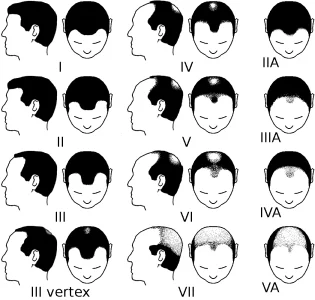Introduction
Hair loss is a common concern affecting millions of men worldwide. The Norwood Scale, developed by Dr. O’Tar Norwood, is the most widely used classification system for assessing the stages of male pattern baldness (androgenetic alopecia). Understanding the Norwood Scale can help individuals better identify their hair loss stage and seek appropriate treatments.
This article delves into the details of the Norwood Scale, explores each stage, discusses its causes, and provides insights into potential treatment options. Additionally, we’ll explain how the Norwood Scale is used in hair transplantation and explore alternatives for managing hair loss effectively.
Common Misconceptions About Hair Loss
1. Myth: Hair loss is caused by wearing hats.
• Fact: Hats do not restrict scalp blood flow or cause baldness.
2. Myth: Frequent washing leads to hair thinning.
• Fact: Washing keeps the scalp healthy and removes excess oils.
3. Myth: Hair transplants are only for the rich.
• Fact: Hair transplant costs have become more affordable, and financing options are often available.

FAQs About the Norwood Scale
1. Can the Norwood Scale predict future hair loss?
• While it helps identify current patterns, progression varies among individuals.
2. At what stage should I seek treatment?
• Early intervention during Stages 2–3 often yields the best results.
3. Is a hair transplant permanent?
• Transplanted hair is resistant to DHT and generally lasts a lifetime.
4. Can women use the Norwood Scale?
• No, the Ludwig Scale is commonly used for female pattern baldness.
What is the Norwood Scale?
The Norwood Scale is a visual representation of the progression of hair loss, ranging from minimal recession to complete baldness. It is divided into seven primary stages, with some stages having subcategories. These categories help doctors and patients identify the severity of hair loss and tailor treatment plans accordingly.

The Seven Stages of the Norwood Scale
Stage 1: Minimal or No Hair Loss
• Hairline remains intact with no significant recession.
• No visible thinning or balding.
• Often considered a baseline for comparison.
Stage 2: Mild Recession
• Early signs of hairline recession at the temples.
• Hair loss is usually symmetrical and subtle.
• Hair density remains unaffected.
Stage 3: Noticeable Recession
• Significant hairline recession, forming a distinct “M” shape.
• Early signs of thinning on the crown may be present in Stage 3 Vertex.
• This stage often marks the beginning of visible baldness.
Stage 4: Advanced Hair Loss
• Hairline recession deepens, and hair loss on the crown becomes prominent.
• A band of hair may still connect the sides and back of the scalp.
• Thinning progresses in both the frontal and crown areas.
Stage 5: Extensive Hair Loss
• The bridge of hair connecting the sides begins to thin.
• Bald areas in the frontal and crown regions start merging.
• Hair loss is more pronounced but still not complete.
Stage 6: Severe Hair Loss
• The bridge of hair disappears entirely.
• Only a horseshoe-shaped band of hair remains on the sides and back.
• Scalp is mostly bare at the top.
Stage 7: Complete Baldness
• Little to no hair remains on the scalp.
• Hair is limited to the sides and back of the head, forming a thin horseshoe pattern.
• The most advanced stage of male pattern baldness.
Norwood Scale in Diverse Populations
Hair loss patterns can vary based on ethnicity:
1. Caucasian Men
• Higher prevalence of advanced Norwood stages.
2. Asian Men
• Slower progression and lower incidence of complete baldness.
3. African Men
• Hair thinning often occurs later in life, with distinct patterns.
Additional Symptoms Beyond Hair Loss
While the Norwood Scale focuses on hair loss patterns, men experiencing androgenetic alopecia may also notice:
1. Changes in Scalp Texture
• Areas affected by hair loss may become shinier due to reduced follicular activity.
2. Itching or Discomfort
• Although not a direct symptom of male pattern baldness, scalp issues like seborrheic dermatitis can coexist.
3. Psychological Impact
• Feelings of stress, anxiety, or reduced confidence often accompany noticeable hair loss.
Causes of Male Pattern Baldness
1. Genetics
Male pattern baldness is hereditary and influenced by androgen-sensitive hair follicles.
2. Hormonal Changes
The hormone dihydrotestosterone (DHT) plays a significant role in shrinking hair follicles.
3. Age
Hair loss becomes more common with advancing age.
4. Lifestyle Factors
Poor diet, stress, and smoking can accelerate hair loss.
How Genetics and Hormones Interact
Male pattern baldness results from a complex interplay of genetic predisposition and hormonal activity. Key points include:

1. The Role of Genetics
• Androgenetic alopecia often runs in families.
• Genetic testing may help predict the risk and progression rate.
2. Hormonal Influence
• DHT (dihydrotestosterone) binds to hair follicles, causing them to shrink (miniaturization).
• Over time, miniaturized follicles stop producing hair altogether.
Treatment Options for Male Pattern Baldness
1. Medications
• Minoxidil: A topical solution that stimulates hair growth.
• Finasteride: An oral medication that blocks DHT production.
2. Hair Restoration Procedures
• Hair Transplant Surgery: Best suited for Stages 4–6.
• Scalp Micropigmentation (SMP): A cosmetic solution to create the illusion of fuller hair.
3. Low-Level Laser Therapy (LLLT)
• Non-invasive treatment that improves hair density and slows hair loss progression.
4. Lifestyle Changes
• A balanced diet, regular exercise, and stress management can improve overall hair health.
Expanding Treatment Options
Advanced Medical Therapies
1. Dutasteride
• Similar to finasteride but more potent in inhibiting DHT.
• Typically used in patients unresponsive to finasteride.
2. Topical Finasteride
• A newer formulation that reduces systemic side effects.
3. Ketoconazole Shampoo
• An antifungal shampoo with mild anti-DHT properties, often used to complement primary treatments.
Norwood Scale and Hair Transplantation
Caring for the Donor Area in Hair Transplantation
Protecting the donor area is crucial for successful hair transplants. Tips include:
1. Avoiding Overharvesting
• Overharvesting can lead to a patchy appearance in the donor area.
2. Post-Surgery Care
• Proper hygiene and avoiding strenuous activities prevent infections.
3. Donor Hair Management
• Using medications like minoxidil to preserve the remaining hair.
For individuals considering a hair transplant, the Norwood Scale is a vital tool in determining suitability and planning the procedure. Hair restoration surgeons rely on this classification to evaluate the severity of hair loss, predict future progression, and ensure the availability of a sufficient and healthy donor area.

How the Norwood Scale Helps in Hair Transplantation
1. Assessing Hair Loss Severity
• Early stages (1–3) may not require a transplant, as non-surgical treatments like medications could be sufficient.
• Advanced stages (4–7) often necessitate surgical intervention to restore hair density.
2. Evaluating Donor Area Quality
• Surgeons assess the density and health of the donor area to determine how many grafts can be harvested.
3. Creating a Long-Term Plan
• Surgeons use the Norwood Scale to predict future hair loss progression.
4. Choosing the Right Technique
• FUE: Suitable for smaller graft requirements.
• FUT: Ideal for higher graft needs.
• Combination Procedures: Used for extensive cases like Stage 7.
Hair Transplantation for Each Norwood Stage
Stages 1–2:
Non-surgical treatments are prioritized.
Stage 3:
Hair transplants focus on restoring the frontal hairline with 1,000–2,500 grafts.
Stage 4:
Restoration targets both the frontal and crown regions, requiring 2,500–4,000 grafts.
Stage 5:
More extensive grafting (4,000–6,000) is needed to cover merging bald areas.
Stage 6:
Multiple sessions may be necessary for optimal results.
Stage 7:
Focuses on creating a natural look with limited donor resources.
Lifestyle and Diet for Hair Health
1. Nutritional Support
• Biotin: Essential for keratin production.
• Iron: Prevents hair shedding due to anemia.
• Omega-3 Fatty Acids: Promotes scalp health.
2. Stress Management
• Chronic stress can worsen hair loss by inducing telogen effluvium.
• Techniques like meditation, yoga, or exercise are beneficial.
3. Hair Care Tips
• Avoid harsh shampoos and frequent heat styling.
• Use a wide-tooth comb to minimize breakage.
Beyond Hair Transplants: Alternatives and Adjunctive Therapies
1. Scalp Micropigmentation (SMP)
2. Hair Systems
3. PRP (Platelet-Rich Plasma) Therapy
4. Low-Level Laser Therapy (LLLT)
Conclusion
The Norwood Scale is an indispensable guide for understanding and managing male pattern baldness. Whether through medications, lifestyle changes, surgical solutions, or alternative treatments, taking action at the right stage can help preserve your hair and confidence.
By consulting with a qualified professional, you can develop a personalized plan that aligns with your goals, ensuring effective results and long-term satisfaction.

